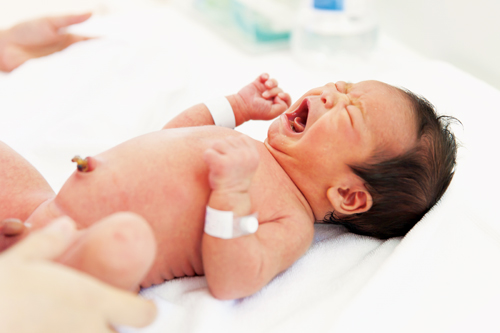Clamp down
You’ve been dreaming about this moment for the past nine […]
You’ve been dreaming about this moment for the past nine months or longer—your little one is finally here! But after the hard work of delivery is done and before you bask in newborn bliss, there’s one more piece of the puzzle to contend with: baby’s umbilical cord.
The cord serves as a lifeline for his time in the womb, so special attention is in order as baby transitions postbirth to his independent self. Here’s everything new parents need to know about clamping, cutting and postpartum umbilical cord care.
For eight or so months, the umbilical cord (which forms around five weeks gestation) carries nutrients and oxygen from you to your baby and delivers deoxygenated blood and waste back to the placenta. At full-term, it contains two umbilical arteries and one umbilical vein. On average, it’s 20 inches long.
After delivery, the cord’s blood vessels are clamped and compressed to stop blood from flowing in either direction. This can occur just after birth, separating the cord from the placenta, as has been standard care in hospital births for decades. Most doctors clamp the cord in two places within a minute after birth before it is cut.
Your doctor or midwife will use two (metal or plastic) clamps: one placed 1-2 inches from baby’s belly button that stops any blood from escaping and jetting out after the cut, and another two finger widths closer to mom that will reduce the amount of blood escaping at the other end. Your partner or care provider can then cut the cord in between the two clamps. Neither mom nor baby feel any pain as the cord is cut because, like your ears, it contains no nerves.
Delayed clamping
Although the majority of Western doctors still clamp the cord within a minute of birth, healthcare providers are taking note of research that suggests baby benefits from delayed cord clamping, or waiting until the cord has stopped pulsating to clamp. Research suggests that the umbilical vein closes slightly later than the umbilical arteries, allowing blood to continue to return to baby in the first few minutes of life, which may offer him a healthy boost.
Mark Sloan, MD, author of Birth Day: A Pediatrician Explores the Science, the History and the Wonder of Childbirth, has written about the benefits of delayed cord clamping. “At term, roughly one-third of a fetus’s blood supply resides in the placenta. In the course of labor and delivery, much of that blood is transfused from the placenta into the newborn, driven by the force of uterine contractions,” he explains. “That transfusion continues beyond the moment of birth; if left undisturbed for one to three minutes, the placenta will deliver about three additional ounces of blood to the newborn.”
Studies have shown that small amount of additional blood can benefit baby in a number of ways, including giving him a healthy supply of iron for three months or longer, which is important for baby’s brain growth and development.
If you are interested in waiting to clamp baby’s cord, speak to your healthcare provider about including this request as part of your birth plan. “Most physicians will take a mother’s desires into account, and as the benefits of delayed clamping are becoming more widely known, many hospitals are changing to make delayed cord clamping standard care in their labor and delivery units,” Sloan says.
Cord care
Regardless of whether you delay clamping, once baby’s cord is cut, there will be a short stump left that should heal and fall off around two weeks postbirth.
Keep it clean and dry as it heals, and give your baby sponge baths during this time instead of placing him in a tub of water. Dress baby in loose clothing, and fold his diaper inward, so it doesn’t rub against the stump.
Any yellow, foul-smelling discharge, redness or bleeding around the stump may be a sign of infection. If the symptoms don’t clear up on their own or the stump hasn’t fallen off after four weeks, reach out to baby’s pediatrician.







